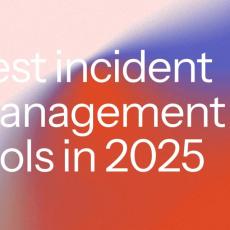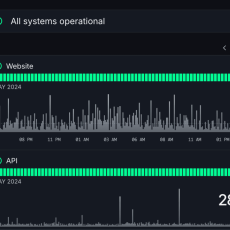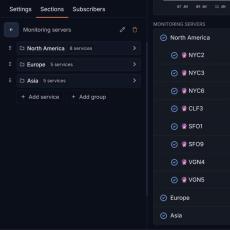|
By Leo Baecker
Datadog is the leader in monitoring software. But that doesn't mean it's the best choice for everyone. And if you're reading this, you probably have your doubts. While Datadog used to be the default choice for DevOps teams, today's organizations often struggle to justify its complex pricing model and steep learning curve. Many companies that started with Datadog have found it becoming prohibitively expensive and harder to use as they scale.
|
By Leo Baecker
Are you looking for a reliable status page solution to keep your users informed? Wondering what alternatives are available to help you communicate system status effectively? While Statuspage.io used to be everyone's default choice, today's DevOps and SRE teams have a hard time justifying this choice. And there are a lot of new tools popping up every year. For this guide, we analyzed 25 tools and we'll explore the best status page software available today.
|
By Leo Baecker
PagerDuty, Splunk, ServiceNow — with dozens of incident management tools on the market, how do you know which one to choose? Here's the reality — downtime costs organizations an average of $9,000 per minute. That's why companies are increasingly investing in incident management tools to reduce disruption and improve their incident response. But with the market evolving rapidly and new players emerging constantly, selecting the right tool has become more challenging than ever.
|
By Leo Baecker
Today we're introducing historical browsing for your status page services. You can now navigate through past incidents and uptime data to get a complete picture of your services' reliability over time.
|
By Leo Baecker
Today we're introducing groups for your status page sections, bringing a new level of organization to your service monitoring. You can now create logical groupings of related services within each section, making your status pages even more structured and easier to navigate.
|
By Leo Baecker
Let's be honest – managing servers isn't getting any easier. With distributed systems, cloud infrastructure, and complex applications, there's more to monitor than ever before. You could try keeping track of everything manually. There's nothing inherently wrong with checking your server metrics yourself and responding to issues as they come up. But here's the reality: if you want to run a reliable, high-performing system, you need proper monitoring tools.
|
By Leo Baecker
I bet every support team lead has had that moment — a critical incident spiraling out of control because nobody knew exactly when or how to escalate it. Been there, done that. But here's the thing — most organizations treat escalation policies as an afterthought, usually cobbling together makeshift procedures only after a major incident has already caused havoc. There's nothing wrong with learning from experience, of course. It's just not the best approach. So what's better?
|
By Leo Baecker
SLAs, SLOs, and SLIs are crucial for managing tech services, ensuring reliability and trust. Learn how these elements work together to maintain service quality and user satisfaction.
|
By Leo Baecker
In today's tech world, clear communication during incidents is crucial. Whether it's a small issue or a major outage, how you communicate with stakeholders can build trust and speed up resolution. This post explores the essential elements of incident communication templates, providing a straightforward guide to crafting clear and concise messages. From planned maintenance to critical system failures, we'll cover a range of templates for different situations, so you're prepared for anything.
|
By Leo Baecker
While most businesses invest heavily in website creation, many overlook the ongoing website maintenance plans needed to keep their digital presence performing at its peak. Data from recent studies reveals a harsh truth: 88% of online consumers won't return to a website after encountering technical issues or outdated information.
- March 2025 (2)
- February 2025 (3)
- January 2025 (5)
- December 2024 (3)
- November 2024 (1)
- February 2024 (4)
- January 2024 (2)
- June 2023 (2)
- May 2023 (1)
- April 2023 (2)
- March 2023 (3)
- February 2023 (2)
- April 2022 (1)
- March 2022 (3)
- February 2022 (3)
- July 2021 (1)
- January 2020 (2)
- July 2019 (1)
- June 2019 (1)
- April 2019 (1)
- March 2019 (1)
Beautifully simple and reliable website monitoring. Receive alerts when your website is down through emails, Slack or SMS, integrated with real time data and insights.
Know when your website is down before your users do with downtime alerts through emails and webhooks, real time data and insights.
Why Hyperping?
- Everything you need, visualized: Monitor your sites with simple and beautiful charts. Measure your uptime, response time and more every minute.
- Get alerted anywhere you are: Seamlessly integrate notification channels for you and your teammates such as Slack, SMS and emails. Get alerts and react before your users even notice.
- Global monitoring: Choose from 10 different locations worldwide. We double check (no false positives) from two more locations whenever an error occurs to confirm downtime.
- Transparency for customer trust: Inform your users about your availability and reliability through the Public Status Page feature. Set up one in seconds.
- Keep control of your branding: Customise your status page by changing your favicon, a custom logo and the color of the graphs.
- SSL Monitoring: Never worry about when your SSL certificate is expired or damaged.
- User Satisfaction: Understand what your users feel when browsing your site.
- Data retention: Go back in time by keeping a large history of your uptime, response time and outages.
Top companies have peace of mind using Hyperping.








